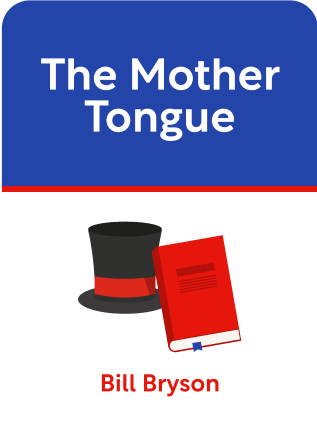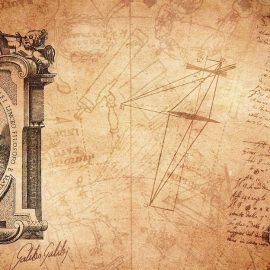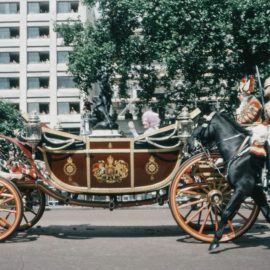

This article is an excerpt from the Shortform book guide to "The Mother Tongue" by Bill Bryson. Shortform has the world's best summaries and analyses of books you should be reading.
Like this article? Sign up for a free trial here .
What is the history of American English? Who brought the English language to the American continent? How did Americans develop their distinct vocabulary and pronunciation?
The history of American English began in the seventeenth century when the first wave of English-speaking settlers arrived in the Americas. Over time, they developed their unique vocabulary and pronunciation, borrowing from the native tongues of the American Indians, the earlier Spanish settlers, and even the French.
Keep reading to learn about the history of American English.
The History of American English
The history of the American English began with the first massive migration of the British settlers. Having arrived on the American continent, they found themselves in a vastly different environment from the one they’d known, filled with plants and animals that didn’t exist in Europe. They needed to invent new words to describe the things they saw.
They often borrowed from the languages of the American Indians, creating anglicized words like hickory, squash, and raccoon. We also see this in place-names like Massachusetts, Connecticut, and Manhattan. They also drew upon words from earlier Spanish settlers, which had often themselves been adapted from the Indian originals by the Spanish. The English-Spanish hybrids include bronco, avocado, and canyon. Lastly, they sourced from the French, which we see in place-names like Illinois, Detroit, and New Orleans, as well as nouns like chowder and prairie.
Over time, English-speaking Americans developed their own unique vocabulary and pronunciations, many of which became widely adopted in England, as well as in whole other languages. The ubiquitous ok is maybe the best example, having worked its way into languages across every inhabited continent. Its history and origins are unclear, although linguists believe it may have arisen out the ironic wordplay of early 19th century American jokesters. Around this time, some well-educated young people in American cities led a fad of creating acronyms for deliberately misspelled phrases—thus, “ok” came from “oll korrect,” meaning “all correct.”
Dialects of English in the United States
The United States is a far more heterogeneous society than the United Kingdom, with a far shorter history. The sheer geographic size of the country, moreover, dwarfs that of the UK. People come to America from all over the world, and no one’s ancestors have been in America as long as many people’s ancestors have been in Britain. The influence of speech and language from other parts of the world is much more immediate and recent in America and is spread over a vastly greater geographical area.
Given this, one might assume a far greater variety of American speech than actually exists. But linguists have found the opposite to be the case. Over the history of its development, American English is remarkably homogenized, to such an extent that speakers on the East and West Coasts (roughly 3,000 miles apart) speak with virtually indistinguishable accents. Of course, regional accents do exist, as anyone who has been in northern New England or the Deep South can attest.
In 1949, Professor Hans Kurath divided the US into four basic speech groups: Southern, New England, Northern, and Midland, though regional subgroups exist within these categories. Kurath also observed that the main dividing lines in American speech ran east to west, with accents becoming more homogeneous and unified the further west one went. The “borders” between these speech groups are fluid, imprecisely defined, and run across vast stretches of the continental US, but they describe the variety of American speech reasonably well.
The speech groups feature differences in pronunciation and word choice. New Yorkers call sugary, carbonated soft drinks soda, while Midwesterners call it pop. Californians are known for adding the definite article before the numbers of interstate highways, talking about “the 101” or “the 80,” which is not seen in other regions of the country. Famously, southerners elongate and drawl their vowels, while New Englanders shorten and clip theirs, rendering words like park as pak. Certain words like balm, bomb, caught, and cot are great signifiers and can tell you easily where someone is from based on how they pronounce them.
The Dictionary of American Regional English (DARE) records over 100,000 variations in the pronunciation and terminology for different words across the US, indicating that there is perhaps far greater linguistic variation in America than Kurath originally observed. This is especially true when one considers the enormous racial and ethnic diversity of the United States, which adds a whole other layer to how English is spoken in the country (DARE under-sampled African-Americans in its initial language survey).
The American Linguistic Melting Pot
As we’ve seen, American English became more homogenous across the vast tracts of the United States, populated by people from all across the globe, than in much-smaller and more ethnically homogenous England.
To be sure, there was an explosion of immigration to the US beginning in the mid-19th century and continuing well into the first two decades of the 20th century. This created ethnic and linguistic enclaves all over the country, with Pennsylvania Dutch speakers in Lancaster County, Pennsylvania; Germans in Midwestern cities like St. Louis and Chicago; Italian- and Yiddish-speaking neighborhoods in New York City; and speakers of Scandinavian languages in the states of the Upper Midwest.
Throughout the history of its development, the speech patterns of American English did not diverge; instead, they converged. The movement of people within the US created a linguistic melting pot of intermingling, which homogenized speech patterns. As time went on, people faced social pressures to conform to “normal” American speech, especially the children of immigrants, who faced even stronger pressure to shed the accents and idioms of their parents.
The Myth of Antiquated Americanisms
It is sometimes said that the physical isolation of certain regions of the US, like the remote communities of parts of the Appalachians, has preserved antiquated dialects of English that date back to Elizabethan times. And it is true that many conventionally “hillbilly” expressions like consarn it and afeared bear the stamp of 16th-century England.
But to say that rural West Virginians are some sort of holdover from that era is to grossly overstate the case. The region wasn’t settled until long after the Elizabethan Age and it was never as isolated from outside influences as these theories suggest.
Americanization of the English Language
In modern history, American English has come to occupy a dominant position. Given its dominant status, it is likely that the English language will become homogenized to conform to the way it’s spoken in the United States. These trends are reinforced by the influences of mass media, which expose the global population to dialects of speech that they would never have otherwise heard.
On the one hand, this is positive. Americans, Britons, Australians, Canadians, South Africans, Jamaicans, and all other English-speaking nations will understand one another better, creating stronger conditions for political, social, and economic cooperation. But, on the other hand, something irreplaceable would be lost—the variety and flavor of our rich and beautiful language.

———End of Preview———
Like what you just read? Read the rest of the world's best book summary and analysis of Bill Bryson's "The Mother Tongue" at Shortform .
Here's what you'll find in our full The Mother Tongue summary :
- How English became a global language
- How the invention of the printing press led to standardization of written English
- Why English dictionaries are the most comprehensive found in any language






